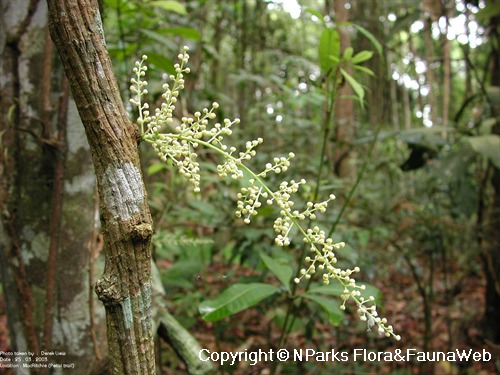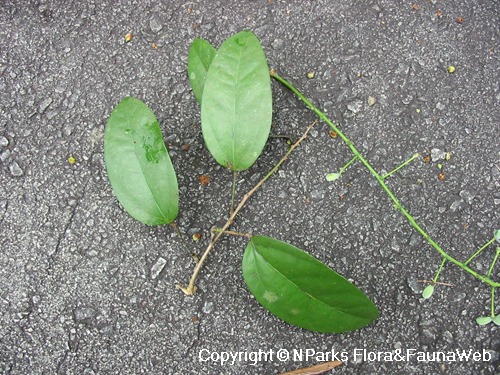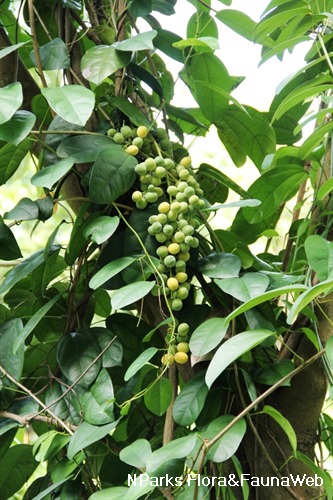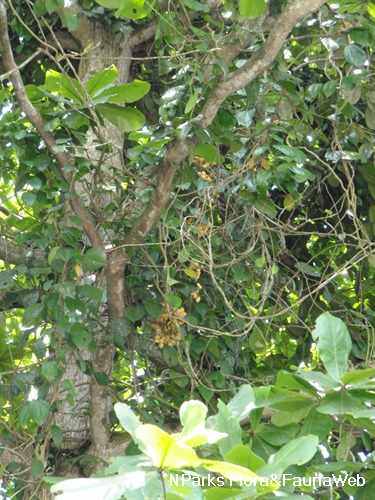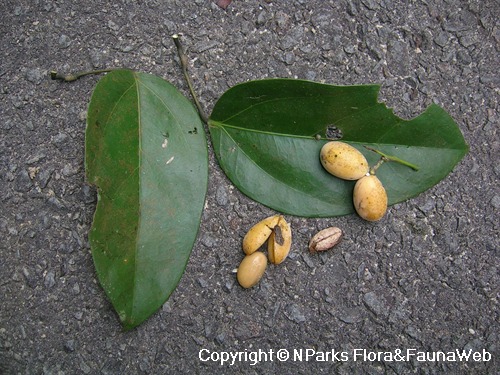
Back
Fibraurea tinctoria Lour.
| Family Name: | Menispermaceae |
| Synonyms: | Fibraurea chloroleuca Miers |
| Common Name: | Akar Badi, Akar Kinching Kerbau, Akar Kuning, Akar Kunyit, Akar Penawar, Sekunyit |
Name
Classifications and Characteristics
| Plant Division | Angiosperms (Flowering Seed Plants) (Dicotyledon) |
|---|---|
| Plant Growth Form | Climber |
| Lifespan (in Singapore) | Perennial |
| Mode of Nutrition | Autotrophic |
| Plant Shape | Irregular |
Biogeography
| Native Distribution | Northeast India, Myanmar, Thailand, Vietnam, Sumatra, Peninsular Malaysia, Singapore, Java, Borneo, northeast Celebes, and the Philippines |
|---|---|
| Native Habitat | Terrestrial (Primary Rainforest, Secondary Rainforest, Coastal Forest, Freshwater Swamp Forest) |
| Preferred Climate Zone | Tropical |
| Local Conservation Status | Native to Singapore (Least Concern (LC)) |
Description and Ethnobotany
| Growth Form | It is a woody climber with yellow wood and tendril-like young shoot tips, up to 40 m long. Its stems produce white latex. |
|---|---|
| Foliage | Its stalked leaves have thinly leathery leaf blades that are elliptic, elliptic-egg-shaped to egg-shaped or oblong-elliptic. The tri-nerved leaf blades are 9–28 by 3.5–14 cm. |
| Flowers | Its branched flowering spikes are 10–38 cm long. Its sweetly scented unisexual flowers are white or yellow. |
| Fruit | Its fruits are yellow to orange, elliptic drupes that are arranged in clusters. |
| Habitat | It grows in lowland forests and forest margins, up to 1,200 m altitude. It occurs locally in Bukit Kallang, Bukit Timah, Central Catchment Nature Reserve, Island Country Club, National University of Singapore, Nee Soon Swamp Forest, Old Turf Club, SAFTI Military Institute, Sentosa, Pulau Tekong, and Pulau Ubin. |
| Associated Fauna | Its flowers are insect-pollinated. The fruits are probably eaten by frugivorous mammals. |
| Cultivation | It can be propagated by seed or stem cutting. |
| Etymology | Latin fibraurea, golden fibers, possibly referring to some species with golden yellow fibers; Latin tinctoria, used for dyeing, indicating the uses of the species |
| Ethnobotanical Uses | Medicinal: The plant contains
berberine, a compound used to treat the eyes. A decoction of the root is
administered after childbirth. Its stem is used for curing an ulcerated nose. A
decoction prepared from the stem is given to patients with dysentery in Java. The
cold compression of the leaves is effective for headaches. Others: Its stem and root were mainly used as a yellow dye in the past. |
Landscaping Features
| Landscaping | It may be suitable for parks and the vertical greening of buildings. |
|---|---|
| Desirable Plant Features | Ornamental Fruits |
| Landscape Uses | Parks & Gardens, Small Gardens, Vertical Greenery / Green Wall, Trellis / Arbour / Pergola |
Fauna, Pollination and Dispersal
| Pollination Method(s) | Biotic (Fauna) |
|---|---|
| Seed or Spore Dispersal | Biotic (Fauna) |
Plant Care and Propagation
| Light Preference | Semi-Shade, Full Sun |
|---|---|
| Water Preference | Moderate Water |
| Plant Growth Rate | Fast to Moderate |
| Rootzone Tolerance | Moist Soils, Well-Drained Soils |
| Propagation Method | Seed, Stem Cutting |
Foliar
| Foliage Retention | Evergreen |
|---|---|
| Mature Foliage Colour(s) | Green |
| Mature Foliage Texture(s) | Leathery |
| Foliar Type | Simple / Unifoliate |
| Foliar Arrangement Along Stem | Alternate |
| Foliar Attachment to Stem | Petiolate |
| Foliar Shape(s) | Non-Palm Foliage (Elliptical) |
| Foliar Venation | Pinnate / Net |
| Foliar Margin | Entire |
Floral (Angiosperm)
| Flower & Plant Sexuality | Unisexual Flowers |
| Flower Colour(s) | Cream / Off-White, White, Yellow / Golden |
|---|---|
| Flower Grouping | Cluster / Inflorescence |
| Inflorescence Type | Spike |
Fruit, Seed and Spore
| Mature Fruit Colour(s) | Yellow / Golden, Orange |
|---|---|
| Fruit Classification | Simple Fruit |
| Fruit Type | Fleshy Fruit , Non-Accessory Fruit |
Image Repository
Others
| Master ID | 105 |
|---|---|
| Species ID | 1401 |
| Flora Disclaimer | The information in this website has been compiled from reliable sources, such as reference works on medicinal plants. It is not a substitute for medical advice or treatment and NParks does not purport to provide any medical advice. Readers should always consult his/her physician before using or consuming a plant for medicinal purposes. |

